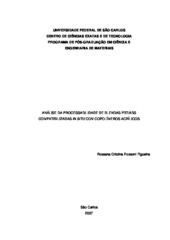| dc.contributor.author | Figueira, Rossana Cristina Rossoni | |
| dc.date.accessioned | 2016-06-02T19:10:06Z | |
| dc.date.available | 2011-11-01 | |
| dc.date.available | 2016-06-02T19:10:06Z | |
| dc.date.issued | 2007-12-14 | |
| dc.identifier.citation | FIGUEIRA, Rossana Cristina Rossoni. Analysis of flowability PBT/ABS blends compatibilized in situ through of addition of reactive copolymers. 2007. 215 f. Tese (Doutorado em Ciências Exatas e da Terra) - Universidade Federal de São Carlos, São Carlos, 2007. | por |
| dc.identifier.uri | https://repositorio.ufscar.br/handle/ufscar/683 | |
| dc.description.abstract | Poly(butylene terephthalate)/acrylonitrile-butadiene-styrene (PBT/ABS) blends show high toughness at room temperature, low ductile-brittle transition temperature and stable morphology when compatibilized. The flowability of PBT/ABS blends compatibilized in situ with methyl metacrylate- glicydil metacrylate-etyl acrylate (MGE) copolymer changes drastically with the kinds of ABS, PBT used and with the level of interfacial adhesion. In this work, a high rubber content ABS was mixed with PMMA and SAN copolymer. These blends were introduced in PBT/ABS/MGE system to study the processability. The addition of ABS/SAN or ABS/PMMA in the PBT/ABS/MGE blends didn t show high decreased of the torque in the blends with rubber content of 12 and 16 wt%. PBT 315/ABS/MGE and PBT 325/ABS/MGE blends showed inversion of viscosity concerning pure ABS under permanent shear condition. The mechanical properties of PBT/(ABS/SAN or PMMA)/MGE showed that the Young modulus and yield stress are not affected by the change of PBT matrix molecular weight. The kind of PBT matrix used changes strongly the blends behavior under impact, altering the values of ductile-brittle transition temperature and impact resistance. PBT 315 and ABS showed almost the same flow length. The compositions with ABS/PMMA added showed a higher flow length tendency in PBT 315 and PBT 325 blends. Blends with PBT 195 showed better flowability. However, these blends didn t become tough systems. The better mechanical properties/moldability relationship to PBT 315 and PBT 325 blends was observed for ABS/SAN or ABS/PMMA added with a rubber content of 30 %wt. | eng |
| dc.description.sponsorship | Universidade Federal de Sao Carlos | |
| dc.format | application/pdf | por |
| dc.language | por | por |
| dc.publisher | Universidade Federal de São Carlos | por |
| dc.rights | Acesso Aberto | por |
| dc.subject | Blendas poliméricas | por |
| dc.subject | PBT/ABS | por |
| dc.subject | SAN | por |
| dc.subject | Processabilidade | por |
| dc.subject | PMMA | por |
| dc.title | Análise da processabilidade de blendas PBT/ABS compatibilizadas in situ com copolímeros acrílicos | por |
| dc.title.alternative | Analysis of flowability PBT/ABS blends compatibilized in situ through of addition of reactive copolymers | eng |
| dc.type | Tese | por |
| dc.contributor.advisor1 | Hage Júnior, Elias | |
| dc.contributor.advisor1Lattes | http://lattes.cnpq.br/1240692926327687 | por |
| dc.description.resumo | Blendas poli(tereftalato de butileno)/acrilonitrila-butadieno-estireno (PBT/ABS) apresentam alta tenacidade à temperatura ambiente, baixa temperatura de transição frágil-dúctil e morfologia estável quando compatibilizadas. O comportamento no estado fundido de sistemas PBT/ABS compatibilizados in situ com o copolímero metacrilado de metila-metacrilato de glicidila-acrilato de etila (MGE) sofre forte influência dos tipos de ABS e PBT utilizados, bem como do grau de adesão interfacial gerado pelo compatibilizante. Neste trabalho, um ABS com elevado conteúdo de fase borrachosa foi diluído com copolímero SAN e PMMA. Estas blendas foram introduzidas no sistema PBT/ABS/MGE para estudo da sua processabilidade. A adição de ABS/SAN ou ABS/PMMA nas blendas PBT/ABS/MGE não apresentou acentuada diminuição do torque tanto nas blendas com proporção mássica de fase borrachosa igual a 12 % como naquelas com 16% em massa. Sob regime permanente de cisalhamento, as blendas PBT 315/ABS/MGE e PBT 325/ABS/MGE apresentam inversão da viscosidade em relação ao ABS puro. As propriedades mecânicas das blendas PBT/[(ABS/SAN ou PMMA)]/MGE mostraram que o módulo de Young e a tensão no escoamento são relativamente insensíveis à alteração da massa molar da matriz PBT numa dada composição. O tipo de matriz PBT utilizada influencia fortemente o comportamento sob impacto das blendas, alterando tanto os valores da temperatura de transição frágil-dúctil como a resistência ao impacto para uma dada temperatura. O PBT 315 e o ABS apresentaram praticamente o mesmo comprimento de fluxo. As composições em que se adicionou ABS/PMMA apresentaram uma tendência a maior comprimento de fluxo tanto nos sistemas com PBT 315 como naqueles com PBT 325. As blendas com PBT 195 apresentam maior habilidade em preencher o molde. Entretanto, estas blendas não resultaram em sistemas tenazes. A melhor correlação propriedades mecânicas/moldabilidade para blendas com PBT 315 e 325 foi para os sistemas onde adicionou-se ABS/SAN ou ABS/PMMA com 30 % em massa de fase borrachosa. | por |
| dc.publisher.country | BR | por |
| dc.publisher.initials | UFSCar | por |
| dc.publisher.program | Programa de Pós-Graduação em Ciência e Engenharia de Materiais - PPGCEM | por |
| dc.subject.cnpq | ENGENHARIAS::ENGENHARIA DE MATERIAIS E METALURGICA | por |
| dc.contributor.authorlattes | http://lattes.cnpq.br/1316851136098325 | por |
